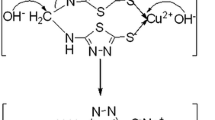Abstract
A simple, sensitive, and specific analytical method has been developed for the quantitative determination of 15 reducing carbohydrates in the soil solution of crop rhizosphere. Reducing carbohydrates were derivatized with 1-phenyl-3-methyl-5-pyrazolone, separated by reversed-phase high-performance liquid chromatography and detected by electrospray ionization tandem mass spectrometry. Lower limits of quantitation of 2 ng/mL were achieved for all carbohydrates. Quantitation was performed using peak area ratios (analyte/internal standard) and a calibration curve spiked in water with glucose-d2 as the internal standard. Calibration curves showed excellent linearity over the range 2–100 ng/mL (10–1,000 ng/mL for glucose). The method has been tested with quality control samples spiked in water and soil solution samples obtained from the rhizosphere of wheat and canola and has been found to provide accurate and precise results.






Similar content being viewed by others
References
Rovira AD, McDougall BM (1967) Microbiological and biochemical aspects of the rhizosphere. In: McLaren AD, Peterson GH (ed) Ch. 16: 417–463, Soil biochemistry, vol. 1. New York, Marcel Dekker Inc
Langemeier JM, Rogers DE (1995) Rapid method for sugar analysis of doughs and baked products. Cereal Chem 72(4):349–351
Miguez BM, De la Montana JM, Garcia JO (2004) HPLC determination of sugars in varieties of chestnut fruits from Galicia (Spain). J Food Compos Anal 17:63–67. doi:10.1016/S0889-1575(03)00093-0
Lee YC (1990) High-performance anion exchange chromatography for carbohydrate analysis. Anal Biochem 189:151–162
Lamari FN, Kuhn R, Karamanos NK (2003) Derivatization of carbohydrates for chromatographic, electrophoretic and mass spectrometric structure analysis. J Chromatogr B 793:15–36. doi:10.1016/S1570-0232(03)00362-3
Perez SA, Colon LA (1996) Determination of carbohydrates as their dansylhydrazine derivatives by capillary electrophoresis with laser-induced fluorescence detection. Electrophoresis 17:352–358
Brunton NP, Gormley TR, Murray B (2007) Use of the alditol acetate derivatisation for the analysis of reducing sugars in potato tubers. Food Chem 104:398–402. doi:10.1016/j.foodchem.2007.01.045
Fraysse N, Jabbouri S, Treilhou M, Couderc F, Poinsot V (2002) Symbiotic conditions induce structural modifications of Sinorhizobium sp. NGR234 surface polysaccharides. Glycobiology 12(11):741–748
Larre-Larrouy MC, Feller C (1997) Determination of carbohydrates in two ferrallitic soils: analysis by capillary gas chromatography after derivatization by silylation. Soil Biol Biochem 29:1585–1589
Chavez-Servin JL, Castellote AI, Lopez-Sabater MC (2004) Analysis of mono- and disaccharides in milk-based formulae by high-performance liquid chromatography with Refractive Index detection. J Chromatogr A 1043:211–215
Shen X, Perreault H (1998) Characterization of carbohydrates using a combination of derivatization, high-performance liquid chromatography and mass spectrometry. J Chromatogr A 811:47–59
Fu D, O’Neil RA (1995) Monosaccharide composition analysis of oligosaccharides and glycoproteins by high-performance liquid chromatography. Anal Biochem 227:377–384
Kang EYJ, Coleman RD, Pownall HJ, Gotto AM Jr, Yang C-Y (1990) Analysis of the carbohydrate composition of glycoproteins by high-performance liquid chromatography. J Protein Chem 9(1):31–35
Meyer A, Raba C, Fischer K (2001) Ion-pair RP-HPLC determination of sugars, amino sugars, and uronic acids after derivatization with p-aminobenzoic acid. Anal Chem 73:2377–2382. doi:10.1021/ac001402s
Saba JA, Shen X, Jamieson JC, Perreault H (1999) Effect of 1-phenyl-3-methyl-5-pyrazolone labelling on the fragmentation behaviour of asialo and sialylated N-linked glycans under electrospray ionization conditions. Rapid Commun Mass Spectrom 13:704–711
Saba JA, Shen X, Jamieson JC, Perrault H (2001) Investigation of different combinations of derivatization, separation methods and electrospray ionization mass spectrometry for standard oligosaccharides and glycans from ovalbumin. J Mass Spectrom 36:563–574. doi:10.1002/jms.158
Usui T, Yoshino M, Watanabe H, Hayase F (2007) Biosci Biotechnol Biochem 71(9):2162–2168. doi:10.1271/bbb.70078
Dalpathado DS, Jiang H, Kater MA (2005) Reductive amination of carbohydrates using NaBH(OAc)3. Anal Bioanal Chem 381:1130–1137. doi:10.1007/S00216-004-3028-9
Honda S, Akao E, Suzuki S, Okuda M, Kakehi K, Nakamura J (1989) High-performance liquid chromatography of reducing carbohydrates as strongly ultraviolet-absorbing and electrochemically sensitive 1-phenyl-3-methyl-5-pyrazolone derivatives. Anal Biochem 180:351–357
Zhang L, Xu J, Zhang L, Zhang W, Zhang Y (2003) Determination of 1-phenyl-3-methyl-5-pyrazolone-labeled carbohydrates by liquid chromatography and micellar electrokinetic chromatography. J Chromatogr B 793:159–165. doi:10.1016/S1570-0232(03)00373-8
Guidance for Industry, Bioanalytical Method Validation (2001) United States Department of Health and Human Services; Food and Drug Administration (USFDA), Rockville. http://www.fda.gov/cder/guidance/index.htm
Acknowledgments
We acknowledge the technical contributions made to this research by Terry Wu and Savka Orozovik and technical discussions with Brady Clark, Fengyang Yan, and Zhonghong Gan. Funding for this project was provided by Alberta Innovates Bio Solutions and Agriculture and Agri-Food Canada.
Author information
Authors and Affiliations
Corresponding author
Electronic supplementary material
Below is the link to the electronic supplementary material.
ESM 1
(PDF 3.07 MB)
Rights and permissions
About this article
Cite this article
McRae, G., Monreal, C.M. LC-MS/MS quantitative analysis of reducing carbohydrates in soil solutions extracted from crop rhizospheres. Anal Bioanal Chem 400, 2205–2215 (2011). https://doi.org/10.1007/s00216-011-4940-4
Received:
Revised:
Accepted:
Published:
Issue Date:
DOI: https://doi.org/10.1007/s00216-011-4940-4




